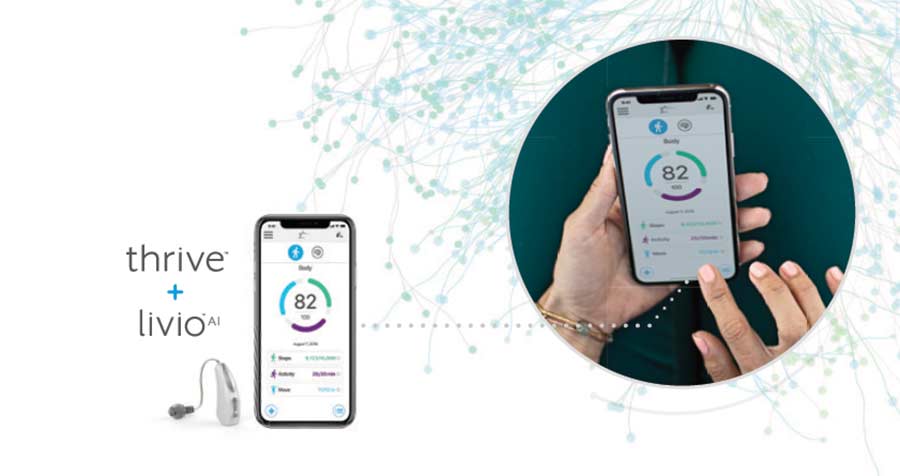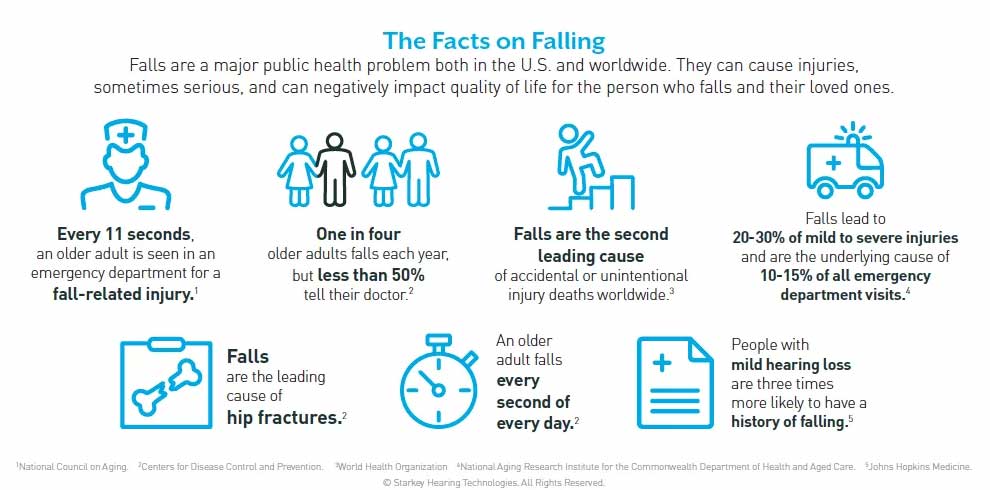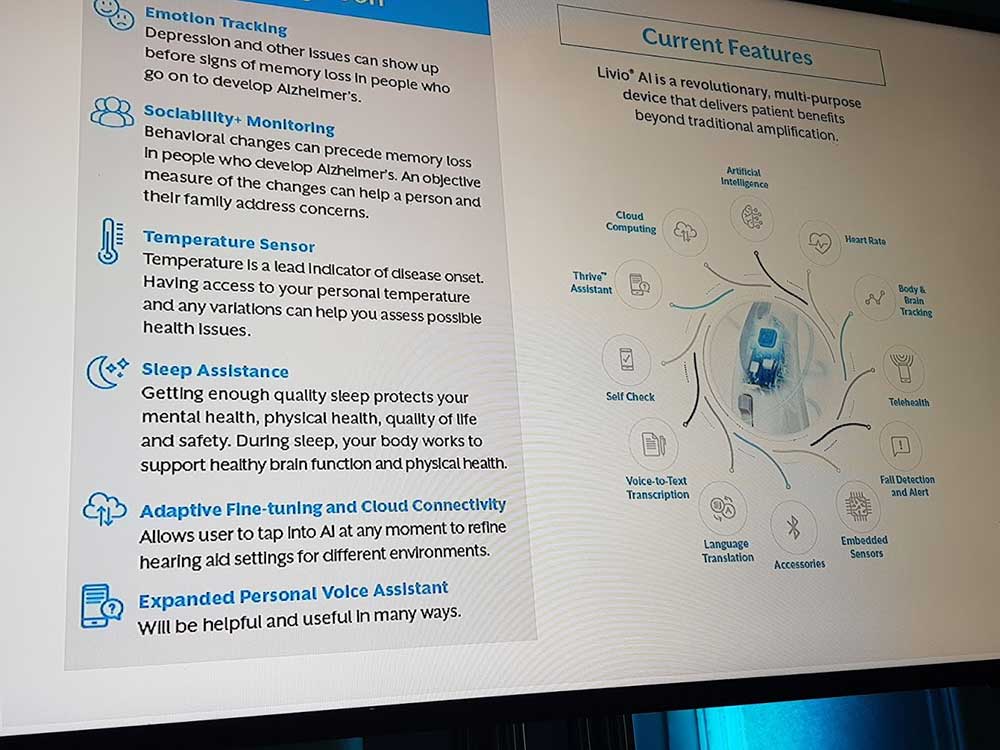Welcome To The Revolution
I really hate trite marketing tag lines, then one comes along that's quite true. Like the famous "Layers of Sound" incident with Resound and their Quattro (actually perfect description for their sound) "Welcome To The Revolution" is exceptionally fitting for the Livio AI. Because that is what it represents, a true revolution in functionality in hearing aids. For the first time ever we have a hearing aid with built-in sensors, health tracking, fall detection and it translates 27 languages in real time. That's pretty revolutionary.

A hearing aid with hearable functionality
I attended the launch of the new Livio AI hearing aid on the 20th of March in London. The device has been a long time coming and the outline of the functionality has excited a lot of people, me included. I believe the device represents a huge move forward within hearing aids. While I have heard a few people say that the wider functionality is just ancillary, I don't agree. I think the features are core to the devices and the users that they are designed for. Let's talk about the devices.
The Sound is Core
I have heard it said several times that sound quality is the true core focus of hearing aids, and that, of course, is true. Up to recently, Starkey really wasn't famous for sound quality, although that changed slightly with the launch of the Muse. Starkey says that the Livio AI represents their very best sound quality yet and they have introduced some new sound processing features to drive that.
Binaural Communication
Starkey is using binaural communication between two Livio AI hearing aids to produce a more natural sound, preserve the natural sound cues and to drive a better experience in noisy situations. That communication also allows them to preserve inter-aural level differences which will allow you to better localise sound. That in itself should help you to separate speech and noise a little better in noisy situations. I had a brief listen to them through headphones and they sounded pretty good. It wasn't a true experience by any means, but with the limited, slightly artificial setup, they sounded okay.
Spatial Speech Enhancement
Starkey says that the new system will deliver a 10% reduction in cognitive effort in noisy environments and a pretty astonishing 80% reduction of noise. That was a little unclear and we didn't have an opportunity to ask questions. As more info becomes available I will update the article to explain what the figures meant.
Transient Noise Reduction
They have introduced a new system to handle transient or impact noises. The system identifies and reduces those noises quickly which means a slamming door or dropped cutlery on a tile floor will not be as irritating.
Bluetooth Hearing Aids
The Starkey Livio AI hearing aids are Bluetooth hearing aids, audio streaming and streaming of phone calls is limited to the iPhone at present. There was no mention of any plans to deliver Made For Android functionality. I am also unsure of how much of the functionality will work with Android phones. I would take it as said that if you want to get the very best out of these aids you need to be packing an iPhone.
The Features
We have touched on the features before here on Know, but let's refresh your memory with a rundown:
- Translation in 27 languages
- Amazon® Alexa connectivity
- Rechargeable option
- Fall Detection and Alerts
- Heart Rate Measurement
- Voice-to-text Transcription
- Natural user interface with tap control
- Self Check for hearing performance
- Thrive Virtual Assistant, built on Google Assistant
I think each of these features is probably worth an article of it's own, but let's run through them and why I think they make complete sense. Translation in 27 languages seems perhaps a little strange, but when you consider that older adults are exceptionally likely to travel it starts to make sense. Starkey says that one of the core beliefs they have is that they enable communication, with live translation of different languages, they are doing that.
Health Monitoring
The Livio AI offers relatively decent health monitoring opportunities, while it monitors activity and now heart rate, it also monitors socialisation and how much time is spent engaging with people. The Thrive App uses all of this to give it's scores.

The health monitoring element of the Livio AI is offered via the Thrive App. It offers two measurements that both deliver the possibility of a score of 100 points. It focuses on a Body score and a Brain score. The body score is calculated through a combination of activity, steps and overall movement. This information is tracked daily and accessed easily in the Thrive app. As I said, a daily score of 100 points is possible.
Cognitive Health
Starkey says that because of the important connection between cognitive health and hearing health, Livio AI measures the brain benefits of wearing hearing aids. I still think that's marketing fluff, however, I have said before, I do believe there is some validity to what they are doing. The metrics used to measure the Brain score include hours of daily use, social engagement and the tracking of active listening. Again the daily score of 100 points is possible.
Does it really give you a score based on cognitive health? No, it doesn't, however, it gives you a clear idea about some of the things that we know promote good cognitive health and I think that is a good thing.
Gamified Health
The idea of the Thrive Health Score is gamification of health, basically, in the same way, the Fitbit or any other healthable does. Your daily scores act as a dare to do better and a beratement that you haven't. As we get older, it is important that we exercise, whether that be focused exercise like gym work or running, or unfocused exercise like nice long walks.
Because there is a huge link between hearing loss and a lot of other co-morbidities like heart disease or diabetes. Enabling health tracking in a hearing aid makes perfect sense, I mean you wear them all day, so they are the ideal device to monitor activity.
Fall Detection & Alerts
Starkey is leveraging the sensors in the Livio AI to detect falls and they have set up a system in the Thrive App that allows an alert to go out to up to three different designated contacts. I honestly think that this is a stroke of genius, I have said for many years that hearing aids could be the ideal platform for the monitoring of activity and health of older people, ensuring that they can lead independent lives for longer. This system represents a big part of that concept.
When you hear the figures (from National Council On Aging) relating to falls for older people it really begins to put the benefit of this feature in perspective:
- Every 11 seconds an older adult is treated in an emergency room for a fall
- Every 19 minutes an older adult dies from a fall
- $67.7 Billion in projected costs from fall by 2020

Older people fall down with alarming regularity and injure themselves, some of them die. The horrible thing is that some who die may have lived if help was quick enough to get to them. That's a hard pill to swallow, and I would imagine it would lead to great torture for a family. The fall detection and alert system mean that if a Livio AI user falls, their loved ones should know about it instantaneously. I think that represents huge peace of mind.
The Self Check
I am telling you, these people are reading my email, I bemoaned the fact several years ago that many hearing aids could be forced to do a self-check of function. I asked why on earth this hadn't been made available to users in the day of Bluetooth connected hearing aids. Starkey was obviously thinking the same thing, they offer a self-check in the Thrive app which will run a subroutine to check your hearing aids. It's a handy tool that allows you to be sure if you need to see your professional or the receiver is just blocked with wax.
Thrive Personal Assistant
Now you are talking, I always wanted my hearing aids to be my personal assistant, mainly because I have a shocking memory for daily life. Appointments, there was an appointment? Emails, oh yes I kind of remember now ish. Yes, that pretty much sums me up, so I live for the day that I have a personal assistant to just manage that. Because my hearing aids are in my ears all day, it makes sense for them to be the primary point of contact for that stuff.
The Thrive Personal Assistant isn't quite there yet, but after talking to Achin Bhowmik, who is the Chief Technology Officer and Executive Vice President of Engineering for Starkey, I can see that it may well be in the future. You activate the Thrive Personal Assistant with a tap on the hearing aids and then simply speak your query. At present, the Thrive Personal Assistant handles queries in two ways.
The AI in the app decides if your query is hearing aid related or a wider general query. If it is hearing aid related such as how do I turn the volume up, the query is handled locally within the app. If it is a wider query, like why is the sky blue?, the app passes it on to Google to answer.
That makes perfect sense, Google, Amazon and Apple have spent ridiculous amounts of money on Artificial Intelligence, why the hell does Starkey need to re-invent the wheel? I had a really interesting conversation with Achin Bhowmik, I even managed not to bow from the waist and give it the old Wayne's World we're not worthy! He had some pretty fascinating things to say about the future of machine learning and AI in hearing aids and some more interesting things to say about new features that will be coming sooner rather than later. I shall cover that conversation in another article and probably a podcast.
The Features of The Future
While the presentation on the day was about existing features, Starkey also gave us a glimpse of future features they expected to introduce.

While the slide covered pretty much everything that was said, including the expanded function for the Personal Assistant that I was hoping for, it didn't mention something that was mentioned by Bill Austin during his closing address. He mentioned a facial recognition system which would help with voice prompts. If they are going to introduce something like that well then they are going to have to put cameras on the aids. Now that would be fascinating.
Like I said at the start, I heard some people say that these features or abilities aren't core, I beg to differ. I think they are as core to the design of modern hearing aids as Bluetooth radios are. Moving forward, consumers will expect this type of functionality because it makes sense. Another thing I heard was, well all of these things have been around for a while and Starkey are just taking advantage of them. My reply was yup, they had the foresight and design thinking to do just that.
Steve Jobs didn't invent anything, he just took lot's of existing technology and features and re-packaged them. The point is that he was the man with the vision to do so, just as Starkey have had the vision to do this. I am no big fan of Starkey, no more than I am a big fan of any particular hearing aid brand, but you have to recognise revolutionary thinking when you see it. Welcome to the revolution, and if the sound quality lives up to the claims, it will be a revolution.
Like us on Facebook by clicking the button below to keep up to date with the latest goings on in our heads, you know you want to.










